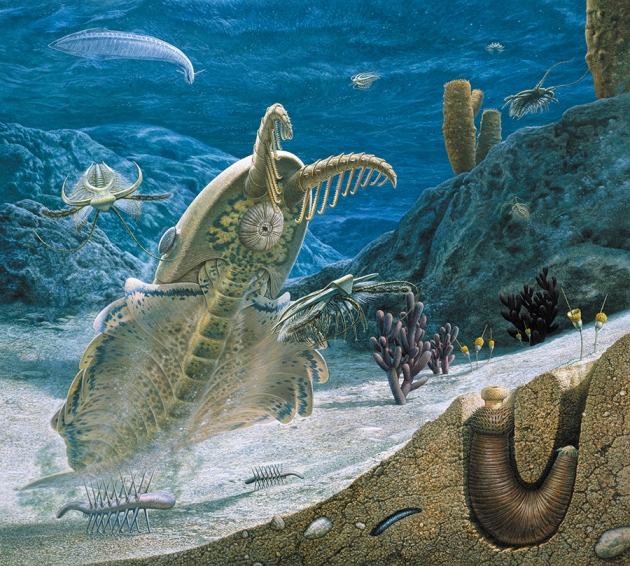When we go back to the Precambrian the differences between plants and animals were probably even less clear," says Fortey. "There isn't any rule that says you have to be demonstrably one or the other."
“要是我們回到寒武紀之前,植物和動物的區別很可能更不明確,”福泰說,“沒有任何規定說,你非得明確不是植物就是動物。”
Nor is it agreed that the Ediacaran organisms are in any way ancestral to anything alive today (except possibly some jellyfish). Many authorities see them as a kind of failed experiment, a stab at complexity that didn't take, possibly because the sluggish Ediacaran organisms were devoured or outcompeted by the lither and more sophisticated animals of the Cambrian period.
關于埃迪亞卡拉動物群在哪個方面是不是今天活著的哪種動物(可能除了水母以外)的祖先的問題,意見也很不統一。許多權威把它們看做是一種失敗的嘗試,想要變成復雜動物而又沒有成功,可能是因為懶散的埃迪亞卡拉動物群給吃了個干凈,或者在競爭中輸給了寒武紀的比較靈活、比較復雜的動物。

There is nothing closely similar alive today, Fortey has written. "They are difficult to interpret as any kind of ancestors of what was to follow."
“今天活著的沒有很類似的動物,”福泰寫道,“它們很難被解釋成是哪種后來出現的動物的祖先。”
The feeling was that ultimately they weren't terribly important to the development of life on Earth. Many authorities believe that there was a mass extermination at the Precambrian-Cambrian boundary and that all the Ediacaran creatures (except the uncertain jellyfish) failed to move on to the next phase. The real business of complex life, in other words, started with the Cambrian explosion. That's how Gould saw it in any case.
我們覺得,它們對地球上生命的發展最終沒有起多大作用。許多權威人士認為,在前寒武紀和寒武紀之交的時候,存在大規模的滅絕現象,埃迪亞卡拉動物群(除了水母不大確定以外)都沒有能進入下一階段。換句話說。正經八百的復雜生命始于寒武紀大爆發。反正古爾德是這么看的。
As for the revisions of the Burgess Shale fossils, almost at once people began to question the interpretations and, in particular, Gould's interpretation of the interpretations.
至于布爾吉斯頁巖化石的重新分類,人們幾乎馬上對那些解釋提出質疑,尤其是對古爾德對解釋進行的解釋。












